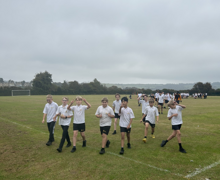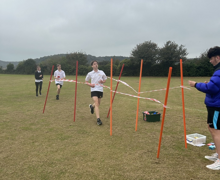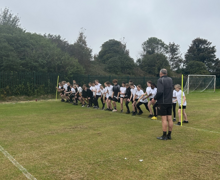Physical Education
KS3 Curriculum
During KS3 students build on what they have learnt in KS1 and KS2, making them more competent and confident in their performance, leading to participation in the more challenging extracurricular sessions.
In KS3 students will participate in five hours of physical education every two-week cycle. Students will have one two-hour lesson and three one-hour lessons.
Term 1 and 2
In these terms Girls learn about football in their two-hour lesson while the boys learn about football. During two of the one hour lesson’s girls learn about basketball while the boys learn about badminton and in the third all students learn about performance skills in dance.
Term 3 and 4
In these terms Girls learn about netball in their two-hour lesson while the boys learn about rugby. During two of the one hour lesson’s girls learn about badminton while the boys learn about basketball and in the third all students learn about Choreographic skills in dance.
Term 5 and 6
In these terms Girls and Boys learn about athletics in their two-hour lesson and during two of the one-hour lessons both girls boys learn about rounders/cricket and outdoor and adventurous activities, while in their third one-hour lesson all will learn appreciation skills in dance.
Health and Fitness
During each term, the practical lessons have an underlying health and fitness area, which the students learn about. This helps them to understand how their body works and therefore how it can be improved, to improve their performance and health. It also gives them an insight into what GCSE physical education involves, shifting the idea that you must be good at sport in order to do well in this course. Each area has several overarching areas, which include preparing and recovering from sport, negative lifestyle choices and how sport and exercise improves mental health. In terms 1 and 2 the students learn about the muscular system and how it responds to exercise and sport, while in terms 3 and 4 the students learn about the cardiorespiratory system and its response to exercise and sport. Finally in terms 5 and 6 the students learn about the different types of fitness and the energy systems and how these are improved tested and used in sport. At the end of each area students sit a test on the area learnt, revision for which can be found below.
KS3 Test Revision Sheets
Cardiorespiratory System Revision
Energy Systems and Fitness Revision
KS4 Curriculum
Throughout KS4 students learn more complex skills and apply them in more challenging situations, building on the skills and principles learnt in KS3, once again leading to participation in extracurricular activities, both in and outside school.
In KS4 students will participate in two one-hour lessons of physical education every two-week cycle. In these lessons students will not only focus on improving their performance, developing their fitness and enhancing their problem-solving skills, but will also continue building on their health knowledge from KS3, focussing on aspects to help them sustain a healthy active life as they move into adulthood. To help facilitate this, we aim to try and keep the lessons fun, active and competitive with the introduction of different activities each half term.
These activities include:
Fitness
Aerobics
Football
Netball
Rounders
Basketball
Resistance training
OAA
Badminton
Extra Curricular Sport
At Astor we offer students the opportunity to further develop their confidence and skills and to challenge themselves even more than in the lessons, by offering a variety of extra-curricular clubs at lunchtime and after school. In addition to these extra-curricular clubs we also run interform competitions, as well as getting involved in inter-school, district and Kent competitions, in which we run teams in all years.
Below is a guide to the extra-curricular clubs running at Astor this term.
GCSE Physical Education
GCSE Physical Education (AQA)
When choosing GCSE physical education, students get six extra one-hour theory/practical lessons per two-week cycle, to prepare them for two exams and to complete a personal exercise plan.
Exam 1
This is a written exam worth 78 marks, that makes up 30% of the overall grade. The exam is 1 hour and 15 minutes long and covers the following:
The human body and movement in physical activity and sport
- Applied anatomy and physiology
- Movement analysis
- Physical training
- Use of data
Exam 2
This is also a written exam worth 78 marks and is also worth 30 % of the overall grade. This exam is 1 hour and 15 minutes long and covers the following:
Socio-cultural influences and well-being in physical activity and sport
- Health, fitness and well-being
- Sport psychology
- Socio-cultural influences
- Use of data
Practical Performance
Students are assessed in three practical areas both internally and externally, which is worth 40 % of the overall grade. The three areas they perform are football/netball, basketball and badminton. Other sports can be assessed instead of the three mentioned, however performers need to be training and competing outside of college and need to be attending the extracurricular clubs for the other school-based activities. Students are given the opportunity to develop their skills in these areas, through their PE lessons, lunch time and after school clubs. Each activity is marked out of 25, the first 10 marks are for the skills in isolation and condition practices. The other 15 marks are awarded to the skills performed in a game.
Included in this area is an analysis of performance where students are assessed on their ability to analyse their own performance and then evaluate it, with the intended outcome being improvement. This area is also out of 25, with the first part being an analysis (strengths and weaknesses), which is out of 15 marks. The second part is an Evaluation (the use of theoretical principles to cause improvement), which is worth 10 marks. (P216 of the spec) This makes the practical and the P.E.P out of 100 marks.
Students are given the opportunity to develop their skills in these areas, through their PE lessons, lunch time and after college clubs. On average students that attend the extra-curricular practices achieve 5-8 marks more than students that do not, which can have a big impact over the three practical activities. Below is the assessment criteria for the sports mentioned.
Here are the subject areas covered over the two year course, with some helpful resource links.
PE Kit and Equipment
Sports equipment
Being organised for their PE lessons is something that we as a department encourage the students to be, as it not only benefits everybody in the lesson but is also a valuable skill students take away from Astor that will benefit them throughout their life.
Below is the equipment they need to bring to all their lessons.
Boys Equipment
Black Astor shorts
White Astor T-shirt
Black and amber rugby shirt
Black football socks
Gumshield (for rugby)
Clean trainers
Football boots (for football and rugby)
In addition, boys can wear black or dark blue tracksuit bottoms over their shorts when it's cold.
Girls Equipment
Black Astor shorts and/or plain black leggings
White Astor T-shirt
Black and amber fleece
Black football socks
Clean trainers
In addition, girls can wear black or dark blue tracksuit bottoms over their shorts/leggings when it's cold.
GCSE and A Level Equipment
For GCSE and A level sport students get to wear a personalised PE top with the course on the back and their initials on the front. For GCSE PE it is a blue and white sports top and for A level it is black and white. These are worn with the Astor black shorts (boys) Astor shorts and/or black leggings (girls) with dark blue/black tracksuit bottoms over the top if it is cold.
Sports tops can be ordered through the PE department.
Safety is always a priority in lessons, therefore hair must be tied back, all jewellery taken of/out, no chewing gum and fingernails kept short.
Athletics
In terms 5 and 6 students will learn about athletics and how to analyse their own and others performance to improve technique and therefore the outcome. During this time they will also learn the rules and health and safety associated with the different events. Whilst doing this in the lesson, students can gain bronze, silver and gold athletics awards. The standards for these awards can be seen below.
Over the years at Astor college many of the students have gone on to exceed these standards and achieve college records. Below is a list of the college records to date.
A Level Physical Education
A LEVEL PHYSICAL EDUCATION AQA
When choosing the A level Physical education course, students study in 9 lessons per two-week cycle, to prepare them for the two written exams and performance analysis and evaluation section that they write. The whole course is out of 300 marks, which is broken down below.
Exam paper 1
Factors affecting participation in physical activity and sport
This is a written exam worth 105 marks of the overall grade, lasts 2 hours and covers the following:
- Applied anatomy and physiology.
- Skill acquisition Section
- Sport and society
Exam paper 2
Factors affecting optimal performance in physical activity and sport
This is a written exam worth 105 marks of the overall grade, lasts 2 hours and covers the following:
- Exercise physiology and biomechanics
- Sport psychology
- Sport and society and technology in sport
Non-exam assessment
Practical performance in physical activity and sport
This part of the course is worth 90 marks of the overall grade. There are 45 marks from the practical performance and 45 marks from the analysis (20 marks) and evaluation (25 marks).
Practical Performance – 45 marks
For this part of the course students can be assessed in the role of the player/performer or coach.
Player/performer
As a player/performer, students will be assessed on their ability to perform both core and advanced skills in attacking and defending as well as their ability to apply tactics and strategies within a full sided competitive game. This area will be out of 45 as the marks show below.
• Area of assessment 1: Technical quality – aspect 1 attacking (15 marks).
• Area of assessment 2: Technical quality – aspect 2 defending (15 marks).
• Area of assessment 3: Application of strategic/tactical awareness (15 marks).
Coach
The coach will be expected to analyse the performance of an individual within a fully competitive/performance context to identify one skill to be developed to enhance performance.
The coach will deliver a planned progressive session to modify the chosen skill so that performance of this skill is refined.
This process should be repeated for each of the Areas of assessment (one skill from Area of assessment 1 attacking, one skill form Area of assessment 2 defending and one skill from Area of assessment 3 tactics and strategies).
The coach will complete this process on a chosen core skill and one advanced skill from each Area of assessment.
Performance analysis assessment (analysis and evaluation) – 45 marks
Performance analysis assessment (analysis and evaluation) Students are required to analyse and evaluate, using appropriate theoretical content included in the specification, a performance as either player/performer or coach, in one activity from the specification. Students can analyse and evaluate their own performance or the performance of another, if it is in an activity that is from the specification. This can be completed either:
• in a purely written format, or
• via a combination of a written format (eg continuous prose/PowerPoint slides etc) and additional verbal explanation (eg expanding on PowerPoint presentation/interview).
Students will be assessed on their performance analysis assessment in the following two skills:
• Analysis (20 marks)
• Evaluation (25 marks)
Written/verbal analysis of performance. 20 marks
Students will be assessed against the levels of response grids. Analysis - Students should identify and explain two weaknesses: one from Area of assessment 2 (defensive skills) and one from Area of assessment 3 (tactics and strategies). The weaknesses can be in their own performance or the performance of another. For each area of assessment, students may choose just one weakness (to show depth of knowledge) or more than one weakness (to show breadth of knowledge), but students must analyse the weaknesses consistently in order to meet the bands in the assessment criteria. Weaknesses must:
• link to either the core or advanced skills/tactics at A-level
• be from a competitive context
• be analysed in relation to the desired outcome (this may be a comparison to an elite performer, correct technical model or own/others' successful performance).
In the role of coach, the student will analyse others' performances within a fully competitive game/ formal conditions and discuss the impact that their weakness(es) have on the performance being analysed.
Evaluation 25 marks
Students must demonstrate their knowledge of theoretical cause(s) and correction(s) for each of the weaknesses identified, ie the weakness(es) from Area of assessment 2 and the weakness(es) from Area of assessment 3. They must demonstrate depth of theoretical understanding across both weaknesses. All causes and corrective measures used by the students must be from the theoretical content within the specification.
Based on the marks the student achieves in the areas above, will determine what grade they receive overall, below is an idea of what can be expected.
A Level physical education grade boundaries
|
|
Max Mark |
A* 60% |
A 53% |
B 46% |
C 39% |
D 33% |
E 27% |
|
PAPER 1 |
105 |
63 |
55 |
48 |
41 |
34 |
28 |
|
PAPER 2 |
105 |
64 |
56 |
49 |
42 |
35 |
29 |
|
NEA |
90 |
76 |
73 |
63 |
54 |
45 |
36 |
|
Total |
300 |
203 |
184 |
160 |
137 |
114 |
93 |
Interform Sport
During the year all students are given numerous opportunities to challenge themselves. One of the ways this opportunity is given, is through interform competitions, where forms in all years compete in a range of sports listed below:
Football
Netball
Badminton
Basketball
Cross Country
Rounders
Athletics - Sports Day
Over the year the points from each event accumilate, with the overall winners from each year group being announced and trophies presented after Sports Day in July.









